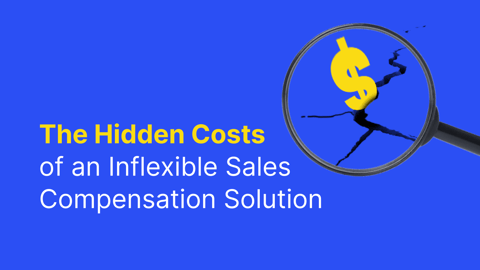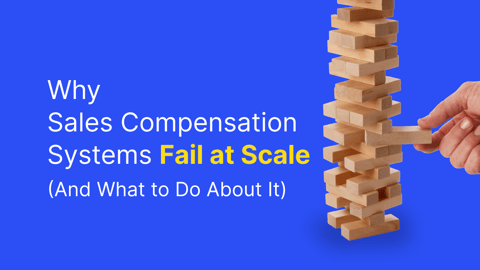For every bit of joy and satisfaction, an incentive compensation statement brings, behind it sits the work, and labor involved in making that happen. And on this occasion, we’re not talking about the blood, sweat, and tears of the sales executive earning it; we’re bringing attention to those teams that oversee the system that manages the incentive compensation schemes. Historically, from inputting the data, through ensuring that every element complied with rules, to dealing with the endless payment queries and disputes from staff, this could be an endless, thankless role of juggling numbers while pacifying those that had cause to believe they had been underpaid.
But this set-up that’s so heavy on administration and weighed down by manual error has been undergoing a welcome transformation. With more sales organizations putting their faith and finances into software platforms that automatically and accurately calculate incentive compensation (along with sales performance management, quota and territory allocation, and commission statement creation) the hours lost to these inefficient jobs and processes are most certainly numbered. Read on to discover how Varicent put their Incentive Compensation Management solution through its paces, and how the results of this participant could transform your own commission structure.
When Incentive Compensation Schemes Go Bad – a Recap
Before looking at the upside and future of incentive compensation schemes (ICM) software, let’s just take a minute to remember the common issues of incentive compensation schemes using some of the takeaways of the Forrester Study, The Total Economic Impact™ of Varicent’s Sales Performance (TEI) as our reference point.
1. Manually inputting across multiple spreadsheets means many mistakes are made: The method of data inputting on behalf of sales executives submitting their numbers and accounts lends itself to error and inefficiencies. And when there are keystroke mistakes, nothing makes sense. Consequently, this draws the attention of not just stakeholders wondering what’s gone wrong, but the auditing and compliance squad, tasked with balancing the books.
2. Multiple platforms and legacy systems equate to a multitude of possible errors: When you’re working with a plethora of platforms, things can quickly unravel. Adjusting calculated incentive compensation schemes results against the reports generated from a quota and territory system can potentially confuse the smartest mathematical and analytical brains. And this takes time, which costs the business money.
3. Mistakes on statements lead to shadow accounting and pay disputes: When the sales professionals calculate they have been underpaid, so begins the shadow accounting and the regular raps on the virtual door of the accounts payable team.
A few, important stats from the Forrester study to illustrate what that looks like in terms of the cost before the changeover to the Varicent ICM solution:
- The average hourly salary of a commission and/or bonus administrator was calculated to be 36 dollars per hour¹.
- In one year, the number of hours for one person spent on creating, implementing, and rolling out commission, was estimated at 125².
- The number of compensation administrators for this was four, plus two further administrators to oversee the bonus schemes³.
That added up to C$3,375,000 that could have been used for a whole lot of other projects, people, or products. So how has this been addressed?
After SPM Implementation – the Present and Future of Managing Incentive Compensation Schemes
Following the implementation of the Varicent SPM software solution which works on one universal platform, the positive changes for the business in the study changed for the better at a pace – especially in how their compensation scheme was managed. The main elements of success were these:
1. Improved Efficiency and Accuracy
Remove the unnecessary processes and spreadsheets, replace them with one system, and you’re on the path to profit. With automated payment software in place to support incentive compensation schemes, and manual inputting from a variety of sources removed, it was noted in the Forrester study that there was a 90 percent increase in payment accuracy within the first year, and revenue recouped was calculated at C$1,425,600, following a risk adjustment of 20 percent.
2. Greater Sales Effectiveness
Give any professional the right tools and they’ll do a far better job than if they’re carving with a blunt and rusty knife. The sales professionals now have access to a transparent incentive compensation scheme that only displays current and accurate information. With less of their working time spent in pay disputes and shadow accounting, they can refocus on what they do best.
3. Increase in Focus and Trust
For team leaders, a well-run and trustworthy incentive compensation scheme make team management much easier. Coaching, team development, and driving revenue once more become the objectives, rather than constantly firefighting. For the business’ monitored in The Forrester study, post-SPM-installation efficiency was calculated to be at a 75 percent raise over the first year. With reliable software in place that proves their efforts are paying off, sales professionals are more comfortable taking on more responsibility and development.
4. Reduces Auditing and Administration Costs and Hours
Auditing and preparing for an audit is not something most businesses look forward to; it's invasive, potentially expensive, time-consuming for everyone tasked with information gathering, and can lay bare a swathe of errors and inaccuracies. But for our business under the microscope, what was the picture after the software change? In short, with every single piece of relevant information on the SPM, the time spent on audits was reduced by 80 percent, and after a risk adjustment of 10 percent, the clawback per year was estimated to save the business C$12,442.
The Time to Change is Now
When your business makes the valuable leap to an integrated software platform to manage both incentive compensation schemes and other sales performance factors, it can seem daunting in the short-term. It may be identified that fewer compensation administrators are required, or the information gained could shine a light on individuals and managers that are far from meeting their targets.
But is that actually a bad thing? Saving money, growing revenue, and gaining the trust and buy-in of your team are just three of the many reasons that prove otherwise.
If you want to discover more about how the Varicent incentive compensation software scheme solution helped to transform the business’ in the study, download the whole paper today – it could help transform your business, too.



